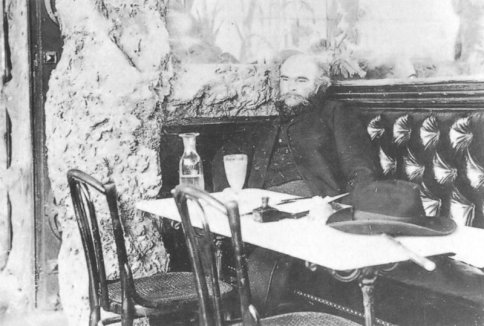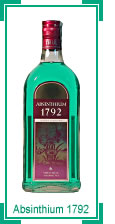Here we have Paul Verlaine, a noted absintheur, with his glass of absinthe at the Café François circa. 1890. The distant gaze, or perhaps as The Tate describes it “stupor”, is typical of the way the absinthe drinker was portrayed at the time. When a statue was erected in this great poet’s honour there was an outcry due to the fact that the pedestal was shaped like an absinthe bottle. Verlaine described absinthe as follows:
“For me my glory is but a humble ephemeral Absinthe drunk on the sly, with fear of treason,and if I drink no longer it is for a good reason.”
Another amusing quote that I spotted recently came from Robert Lehrman, an attorney in Washington D.C
“absinthe without thujone is like Playboy without the photos”
Does USA approved absinthe have thujone or not? The answer is that nobody knows: The FDA (27 CFR 13.51) maintains that absinthe must be thujone free – so that seems clear enough. However, due to a margin of error within the TTB system it seems that absinthe with less than 10 parts per million registers as zero thujone. This means that your USA approved absinthe might have anything from 0-10 parts per million contained within it. Don’t expect the manufacturers to specify the level – as they won’t! Why that is I leave for you to work out.
Accodring to a post on a web forum there is a big difference between Lucid Absinthe & Kubler (both available in the USA). The reason why Lucid was first off the block, according to the post, is that it contains NO THUJONE whatsoever:
Lucid wasn’t just under 10ppm. It has no thujone at all. That’s why it was approved so quickly. When Lucid was approved there were calls to the TTB asking what was going on.No thujone at all and you get approved fast (by their standards).
What we do know for sure is that new scientific techniques have been suggested to eliminate the natural thujone content of the real wormwood plant. These include plant chemo-types and “superficial carbon dioxide” extraction, interesting that there is now a chemo-type of non-thujone bearing Artemisia absinthium. I suppose that Absente (absinthe redefined) which uses Artemisia abrotanum, instead of Artemisia absinthium, could start using this wormwood mutation as well? It would seem to make sense. How the manufacturers are delivering these thujone compliant absinthes from the pot is shrouded in mystery – just like the thujone content itself.
It should be noted that many high profile hyped absinthes like La Clandestine also avoid telling their consumers the thujone content. The answer given by them is “It complies with the relevant legislation in most countries” This despite Lemercier Amer d’Absinthe 72% from France having an “unusually high” thujone level of 30mg according to some websites.
Whilst some absinthe manufacturers remain shy about the thujone content of their absinthe the following can be used as a guide : “Horka Lihovina”,“Amer aux Plantes d’Absinthe” or “Bitterspirituose” in Czech, French and German respectively. These are the designations for absinthe with greater than 10mg thujone/l.
I fail to see why manufacturers can’t simply specify the level – consumers want to know. What’s the reason? Care to hazard a guess anyone?
Here’s the USA thujone free definition if that helps at all:
Thujone-Free.
We approve the use of the term “absinthe” on the label of a distilled spirits product and in related advertisements only if the product is “thujone-free” pursuant to the Food and Drug Administration’s (FDA) regulation at 21 CFR 172.510. Based upon the level of detection of FDA’s prescribed method for testing for the presence of thujone, TTB considers a product to be “thujone-free” if it contains less than 10 parts per million of thujone. However, should the FDA set a new standard for “thujone-free,” in accordance with 27 CFR 13.51, COLAs that are not in compliance with that revised standard will be revoked by operation of regulation.
Source: Alcohol and Tobacco Tax and Trade Bureau













